What Are The Oldest Skyscrapers In The United States?
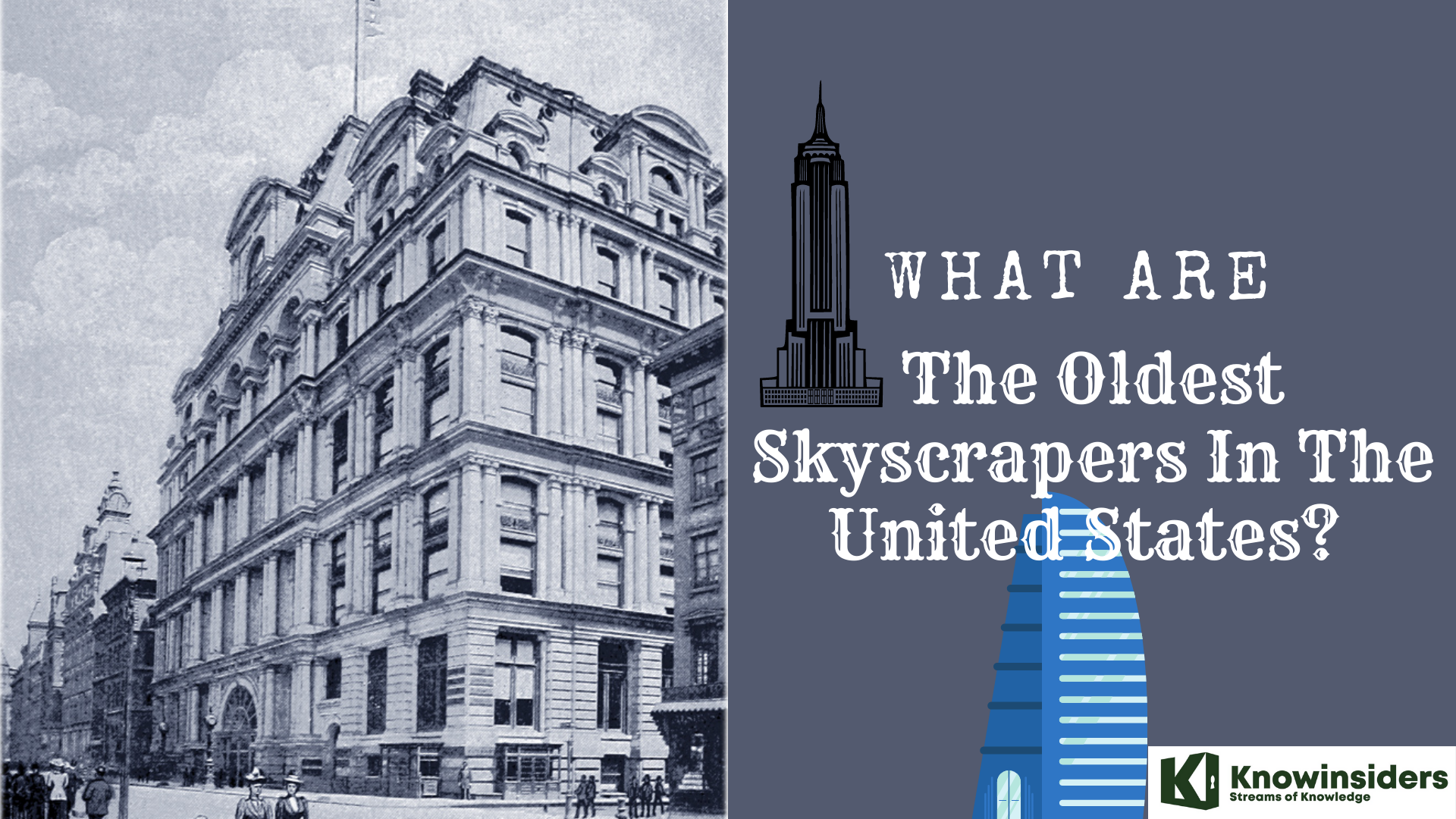 |
| What are the oldest skyscrapers in the United States? |
Skyscraper, a very tall multistoried building. The name first came into use during the 1880s, shortly after the first skyscrapers were built, in the United States. The development of skyscrapers came as a result of the coincidence of several technological and social developments. The term skyscraper originally applied to buildings of 10 to 20 stories, but by the late 20th century the term was used to describe high-rise buildings of unusual height, generally greater than 40 or 50 stories.
The increase in urban commerce in the United States in the second half of the 19th century augmented the need for city business space, and the installation of the first safe passenger elevator (in the Haughwout Department Store, New York City) in 1857 made practical the erection of buildings more than four or five stories tall. Although the earliest skyscrapers rested on extremely thick masonry walls at the ground level, architects soon turned to the use of a cast-iron and wrought-iron framework to support the weight of the upper floors, allowing for more floor space on the lower stories. James Bogardus built the Cast Iron Building (1848, New York City) with a rigid frame of iron providing the main support for upper-floor and roof loads.
The first skyscraper in the world
The world’s first skyscraper was the Home Insurance Building in Chicago, erected in 1884-1885. The so-called “Father of the Skyscraper” towered all of 10 stories with its peak at 138 feet, miniature by today’s standards but gargantuan at that time. The architect, Major William LeBaron Jenney, incorporated a steel frame that supported not only the walls but the great weight of the entire building. The exterior, however, was made of brick. This technique spawned a new type of construction referred to as the “Chicago Skeleton.” The landmark building did not last…it was demolished in 1931 which was ironically, the year that The Empire State Building in New York was completed.
There are many famous skyscrapers that initiated the creation of beautiful skylines in cities across the country. Many of these buildings are still standing. Here are some of the oldest skyscrapers in the US.
The List of top 10 oldest buildings in the United States
10. Rookery Building
9. Sun Building
8. Hotel Chelsea
7. Home Insurance Building
6. Produce Exchange
5. Temple Court Building and Annex
4. Phelan Building
3. New York Tribune Building
2. Equitable Life Building
1. Delaware Building
***
What are the oldest buildings in the United States?
10. Rookery Building
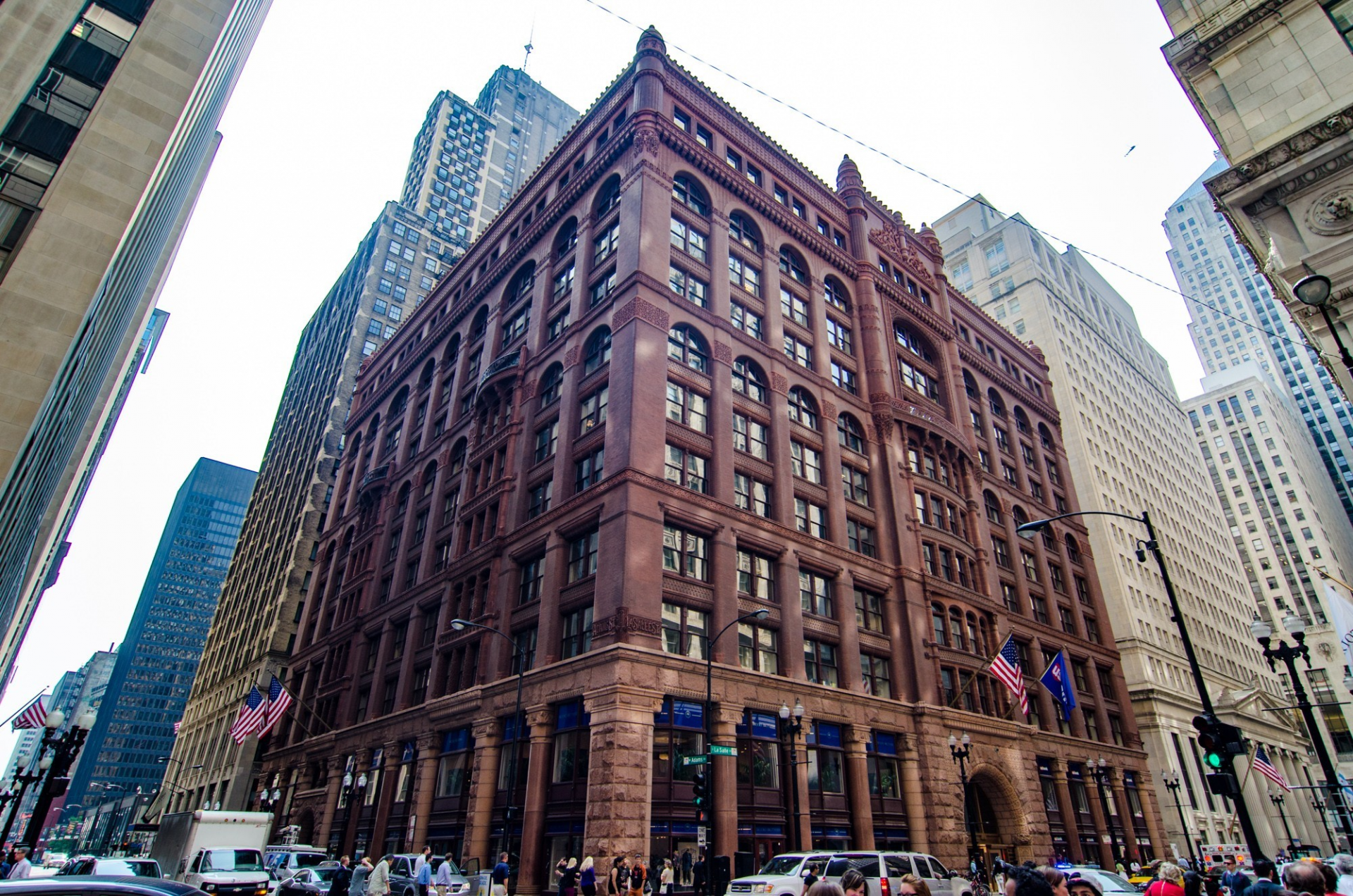 |
| Photo: Chicago Architecture Centre |
As one of the most historically significant buildings in Chicago, The Rookery is a unique enclave for businesses that value a prestigious presence. An icon in the center of Chicago's downtown Financial District, The Rookery seamlessly combines the flair of an era gone by with state-of-the-art building systems and technology. Designated a Chicago Landmark in 1972 after being added to the National Register of Historic Places in 1970, The Rookery is universally considered an architectural masterpiece.
Designed by famous architectural partners Burnham and Root, the picturesque Rookery was originally completed in 1888. Adding to its impressive stature, Frank Lloyd Wright redesigned the stunning two-story, sky lit lobby in 1905. Meticulously renovated and maintained, The Rookery stands as one of the most highly recognized addresses in all of Chicago.
Located in the heart of downtown Chicago’s financial district, The Rookery was built to be a prestigious business environment. The building has an unrivaled history and has proven, throughout generations, to be a place of bold progress and great success.
9. Sun Building
 |
| Photo: Wikimedia Commons |
The Sun Building (also known as the Baltimore Sun Building or American Bank Building) is an historic building, located at 1317 F Street, Northwest, Washington, D.C., in the Downtown Washington, D.C. neighborhood.
The Sun Building (also known as the Baltimore Sun Building or American Bank Building) was designed in 1885-87 by nationally recognized architect Alfred Bult Mullett for A.S. Abell, publisher of the Baltimore Sun, as the paper's Washington news bureau. The building was constructed by John H. Hewlett. A contemporary account stated that "'The Sun Building marks, it is believed, a new era in building in Washington." This new era was characterized by rapidly developing technologies. At the time of its construction, the Sun Building was viewed as one of Washington's most distinguished new business structures. The building stands as a fine example of the Victorian Gothic style of architecture.
Today, the Sun Building retains the exuberant character and strong visual presence that distinguished it in 1887. Its exterior has been carefully restored to the original design. Only the demolished steeple could not be rebuilt. The upper interior spaces retain their original finishes and detailing. The interior commercial spaces and lobby were returned to the original conformation, while accommodating modern conveniences and complying with building and safety codes.
8. Hotel Chelsea
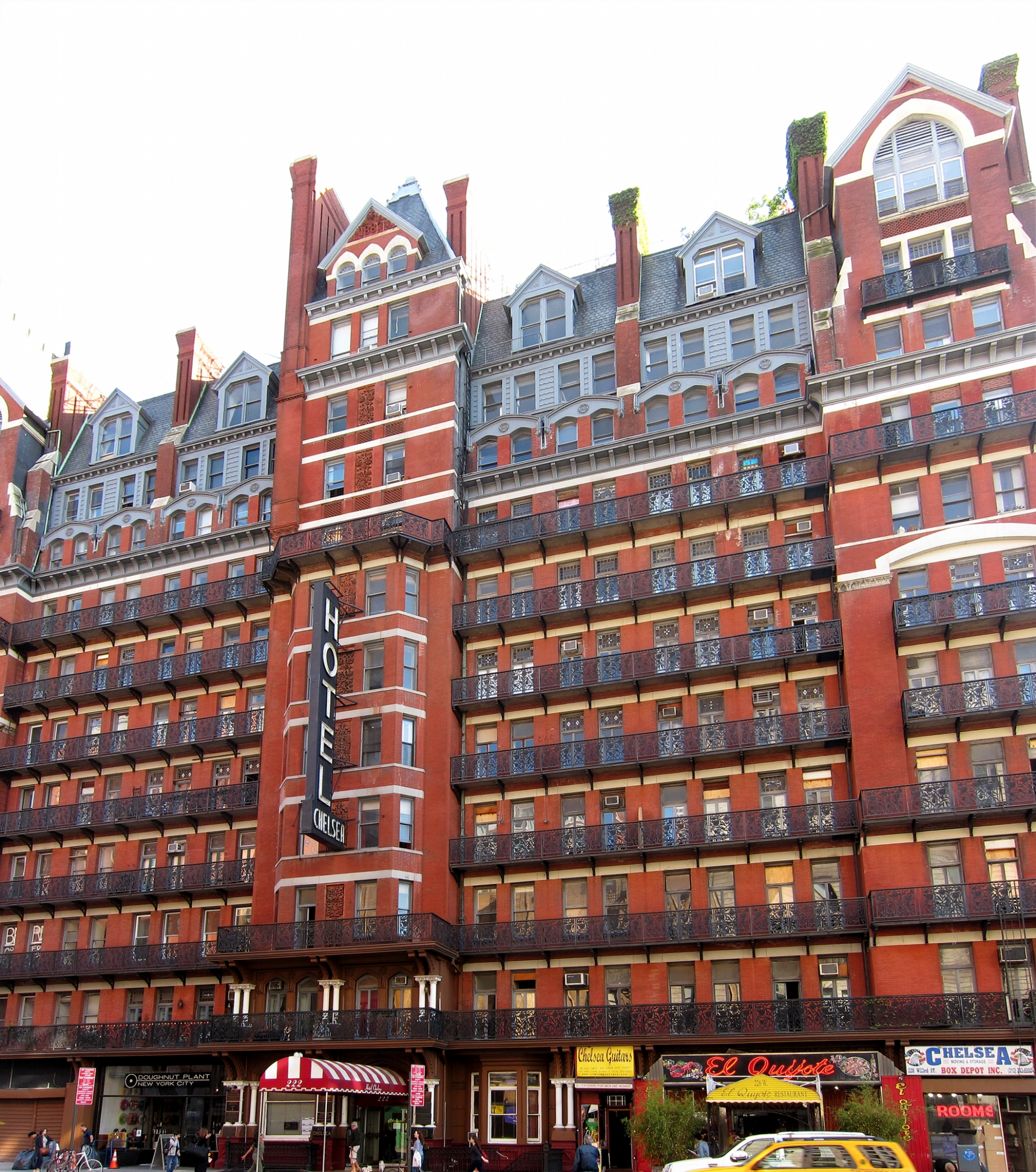 |
| Photo: Wikipedia |
Today the halls of the Chelsea Hotel are salted with dust. The hundreds of paintings that adorned its walls have been locked away in storage. The doors to abandoned apartments are whitewashed and padlocked. Hotel operations ceased in 2011 for the first time in 106 years, and now the few remaining residents roam the echoing corridors like ghosts. They have watched workers haul out antique moldings, stained glass, even entire walls. Ancient pipes ruptured during renovations, flooding apartments, and neighbors returned home from work to find their front doors sealed in plastic wrap. The Chelsea’s new owners say that the building had fallen into dangerous disrepair, and they are restoring it to its original condition. Some residents believe that they are being forced out, and that the Chelsea as they know it—and as it was known to residents from Sherwood Anderson and Thomas Wolfe to Sid Vicious and Jasper Johns—will soon vanish before the city’s merchant greed.
Dystopias always begin as utopias, and the Chelsea is no different. Though in its current state it bears an unfortunate resemblance to Los Angeles’s Bradbury Building as transfigured in Blade Runner, the Chelsea was originally conceived as a socialist utopian commune. Its architect, Philip Hubert, was raised in a family devoted to the theories of the French philosopher Charles Fourier, who proposed the construction of self-contained settlements that would meet every possible professional and personal need of its inhabitants. After the stock-market crash of 1873, Hubert decided New York was ready for its own Fourierian experiment and devised a plan to build cooperative apartment houses in New York City. Tenants would save money by sharing fuel and services. Hubert’s creations—New York City’s first co-ops—were tremendously successful, and none more so than the Chelsea, which opened in 1884. Keeping with Fourier’s philosophy, Hubert reserved apartments for the people who built the building: its electricians, construction workers, interior designers, and plumbers. Hubert surrounded these laborers with writers, musicians, and actors. The top floor was given over to 15 artist studios. Hudson River School paintings hung in the common dining rooms, and the hallways and ceilings were decorated with natural motifs. At 12 stories, the Chelsea was the tallest building in New York.
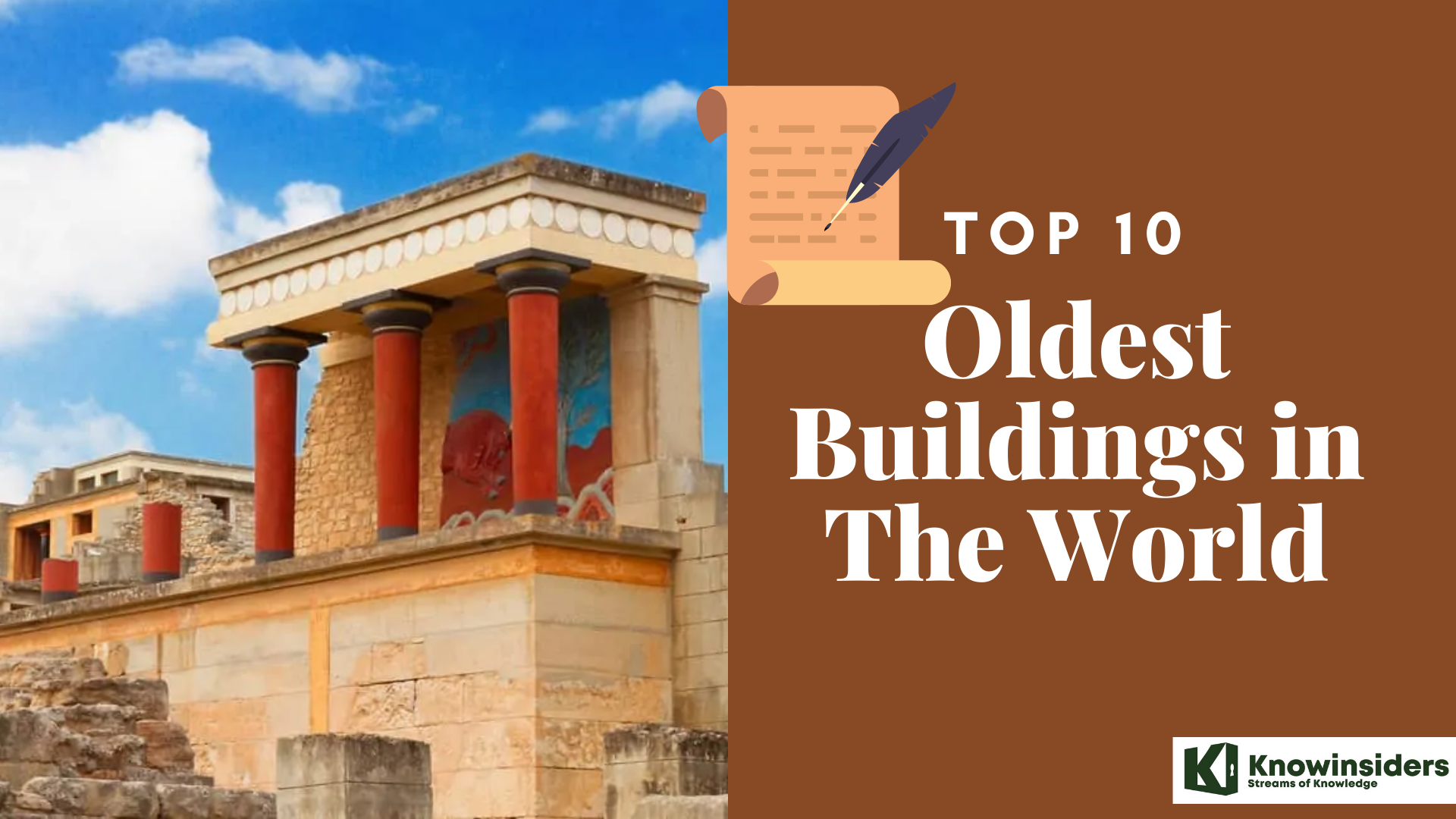 Top 10 Oldest Buildings In The World - The First Buildings Top 10 Oldest Buildings In The World - The First Buildings Keep reading the detailed article below for the list of top 10 oldest buildings in the world - The First Buildings. |
7. Home Insurance Building
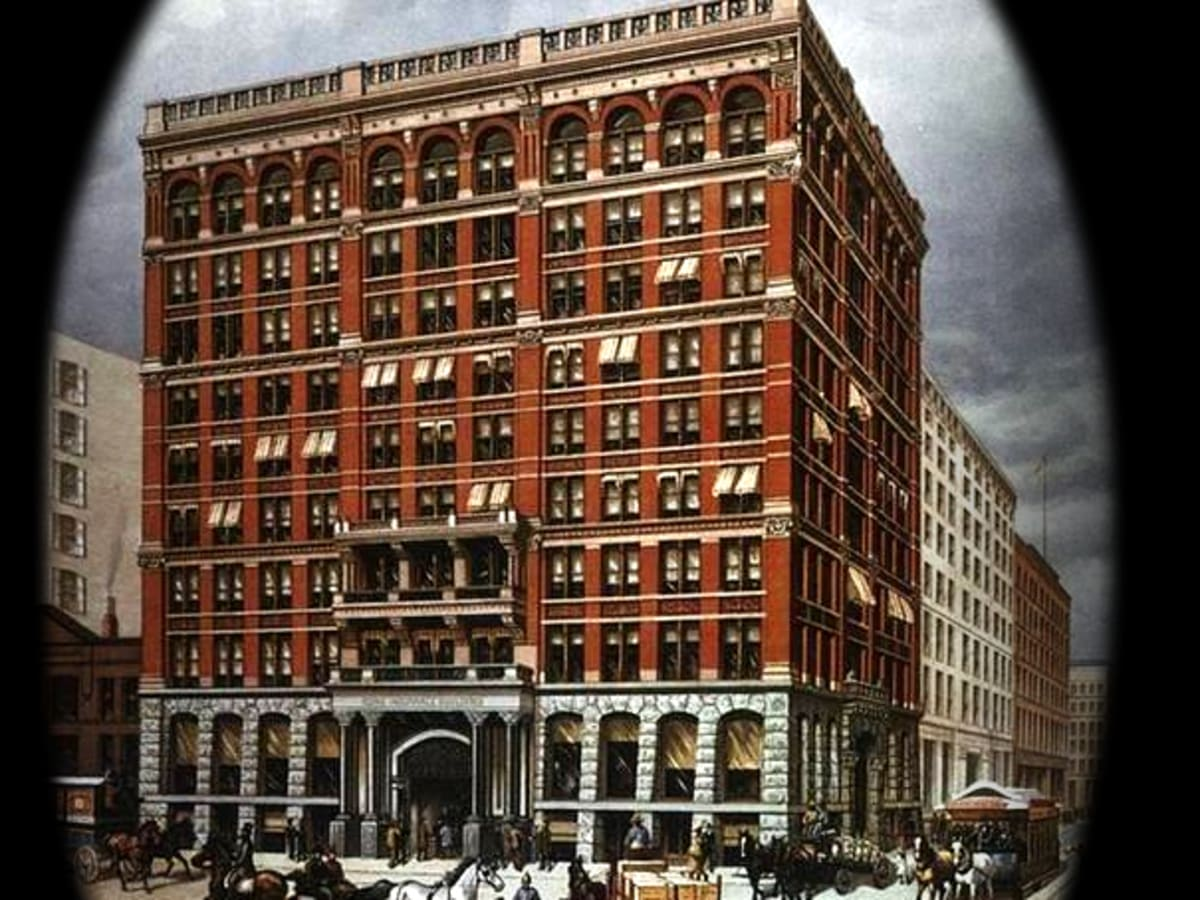 |
| Photo: History |
The Home Insurance Building was completed in 1885; it originally had 10 stories and stretched 138 feet in the air. During its construction, city authorities were so worried that the building would topple over that they halted construction for a period of time so that they could ensure its safety. In 1890, two additional floors were added at the top, bringing the total height to 180 feet (55 meters). In addition to being the first of a new generation of steel-framed skyscrapers built in cities across America and the world, the building set the standard for various other building innovations, including rapid, safe elevators, wind bracing and modern plumbing.
Jenney’s achievement paved the way for the work of a group of architects and engineers that would become known as the Chicago School; together, they would develop the modern skyscraper over the last years of the 19th century and the first years of the 20th. Several important members of this group worked at one time in Jenney’s office, including Daniel Burnham (who would go on to design New York City’s iconic Flatiron Building), John Root and Louis Sullivan. Though New York would later become known for taking skyscrapers to new heights, Chicago has retained its title as the birthplace of the skyscraper, thanks to Jenney and the rest of the Chicago School. The first of these historic buildings, Jenney’s Home Insurance Building, was demolished in 1931 to make way for the Field Building (now known as the LaSalle Bank Building).
6. Produce Exchange
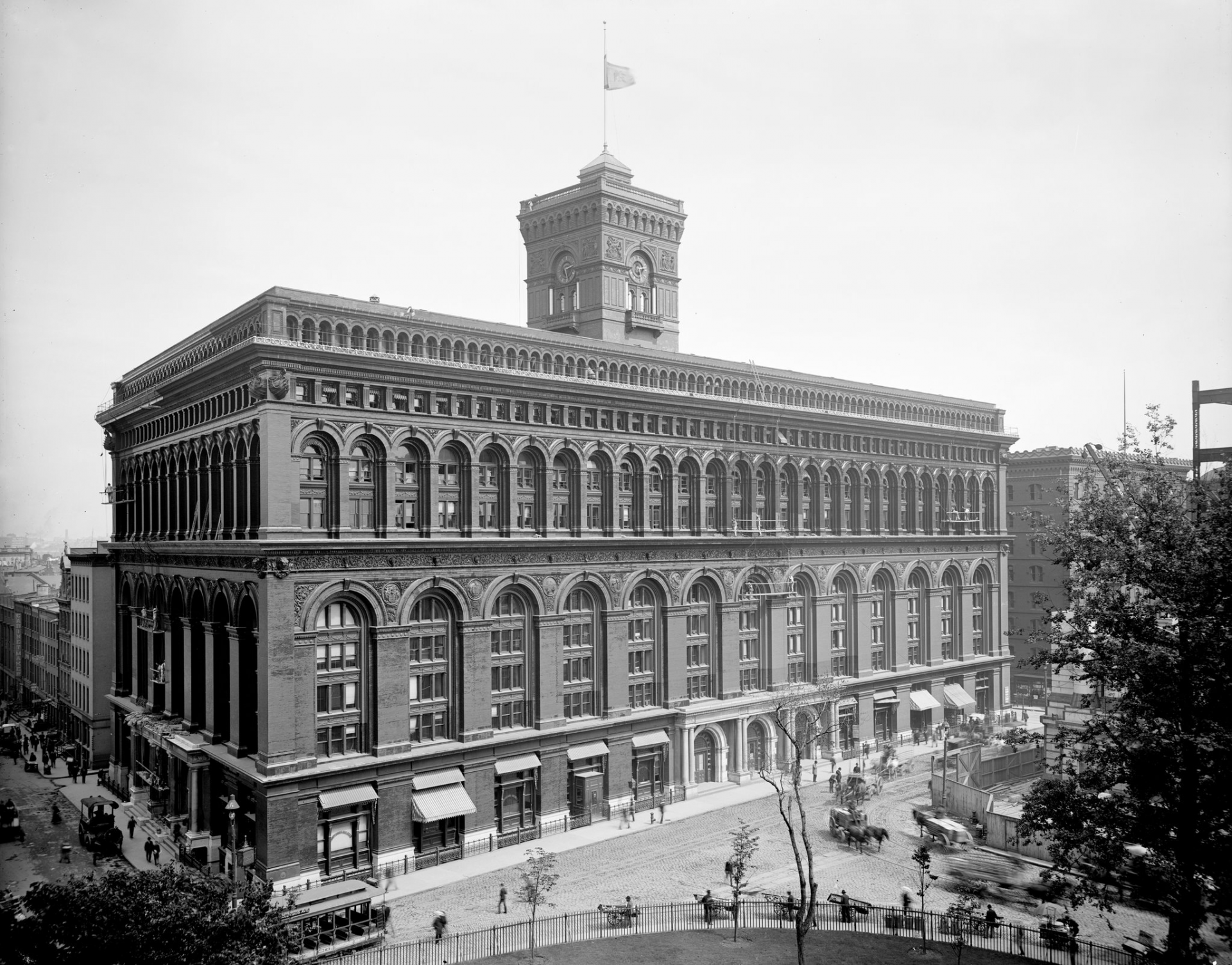 |
| Photo: The New York Times |
The New York Produce Exchange was a commodities exchange headquartered in the Financial District of Lower Manhattan in New York City. It served a network of produce and commodities dealers across the United States. Founded in 1861 as the New York Commercial Association, it was originally headquartered at Whitehall Street in a building owned by the New York Produce Exchange Company. The Association was renamed the New York Produce Exchange in 1868 and took over the original building in 1872.
Between 1881 and 1884, the Produce Exchange built a new headquarters on 2 Broadway, facing Bowling Green in Lower Manhattan. The structure, designed by George B. Post, was the first in the world to combine wrought iron and masonry in its structural construction. The main feature of the structure was an exchange floor that measured approximately 220 by 144 feet (67 by 44 m). The Produce Exchange was profitable following the building's completion. By the 1880s, it had the largest membership of any exchange in the United States, with a maximum of three thousand members. By 1900, the exchange was doing $15 million a day in business.
In the early 20th century, activity on the Produce Exchange started to decline due to competition from other cities. The Produce Exchange sold off its building for development in the 1950s; the headquarters was demolished to make way for a skyscraper called 2 Broadway. The exchange had its trading floor in the skyscraper from 1959 until 1973, when it was restructured as the Produce Exchange Realty Trust, a real estate investment trust.
5. Temple Court Building and Annex
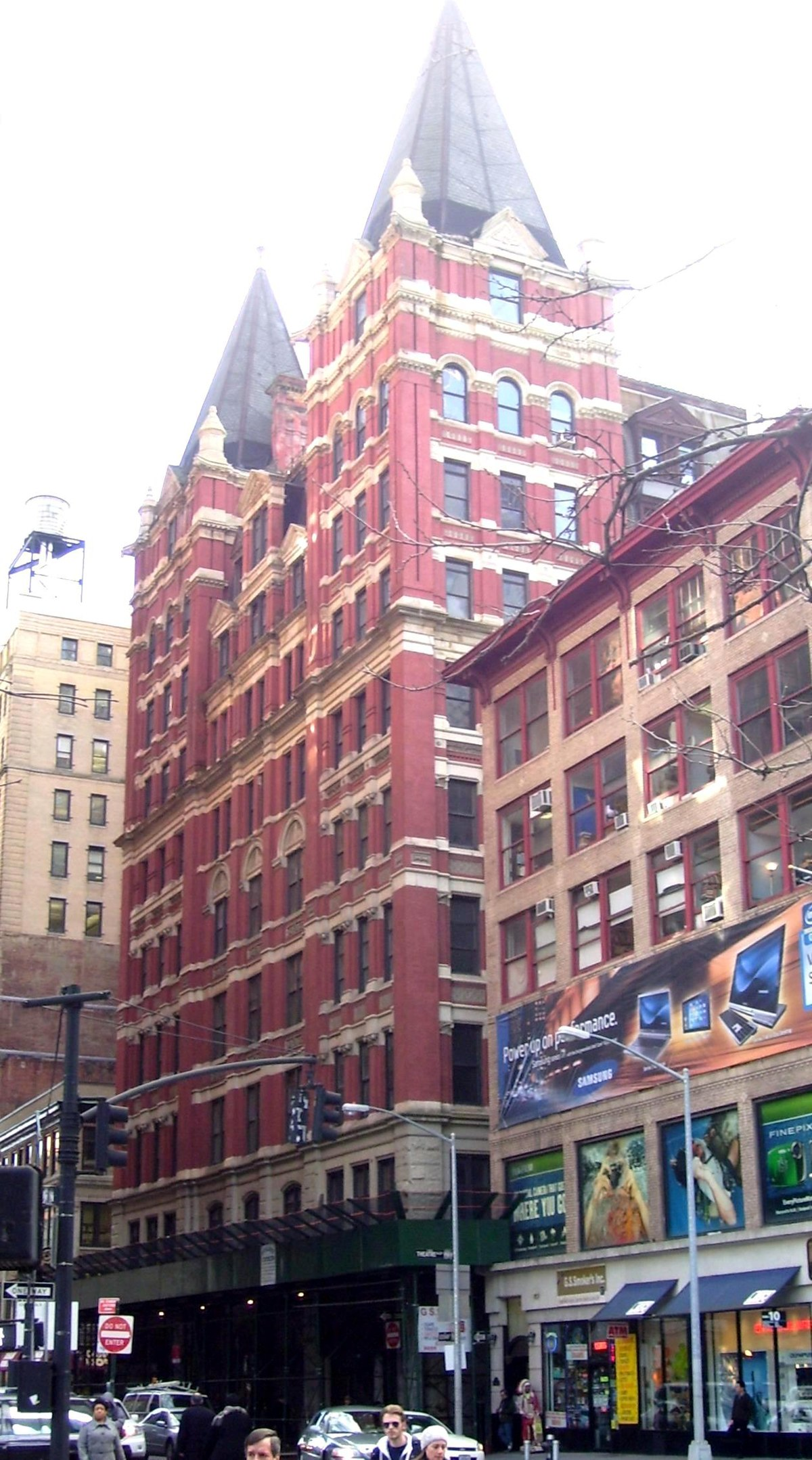 |
| Photo: Wikipedia |
Temple Court Building was commissioned by Eugene Kelly, an Irish-American multi-millionaire-merchant-banker. Executed in red Philadelphia brick, tan Dorchester stone, and terra-cotta above a two-story granite base, the handsome vertically-expressed design employs Queen Anne, neo-Grec, and Renaissance Revival motifs.
The Temple Court Building and Annex is an early example of the use of brick and terra-cotta for the exterior cladding of tall office buildings in the 1870s and 80s, as well as a rare surviving office building of its era constructed around a full-height interior skylighted atrium. Its two towers foreshadow the pyramidal form that later became popular for skyscrapers.
4. Phelan Building
 |
| Photo: Wikipedia |
The Phelan Building is an 11-story office building located at 760 Market Street in the Financial District of San Francisco, California. It has a triangular shape reminiscent of the Flatiron Building in Manhattan, New York City, with its tip at the meeting point of Market Street, O’Farrell Street, and Grant Avenue. It is a San Francisco Designated Landmark.
The building was designed by William Curlett and built in 1908 by James D. Phelan on the place of the first, original Phelan Building, damaged by the 1906 earthquake and fire.
The first Phelan Building was constructed in 1881 by James Phelan, the father of James D. Phelan. It was a 6-story, bay-windowed, mansard-roofed flatiron. Despite being advertised as “thoroughly fire and earthquake proof”, the building was badly damaged in the 1906 post-earthquake fire, and its ruins were subsequently dynamited on April 20, 1906.
3. New York Tribune Building
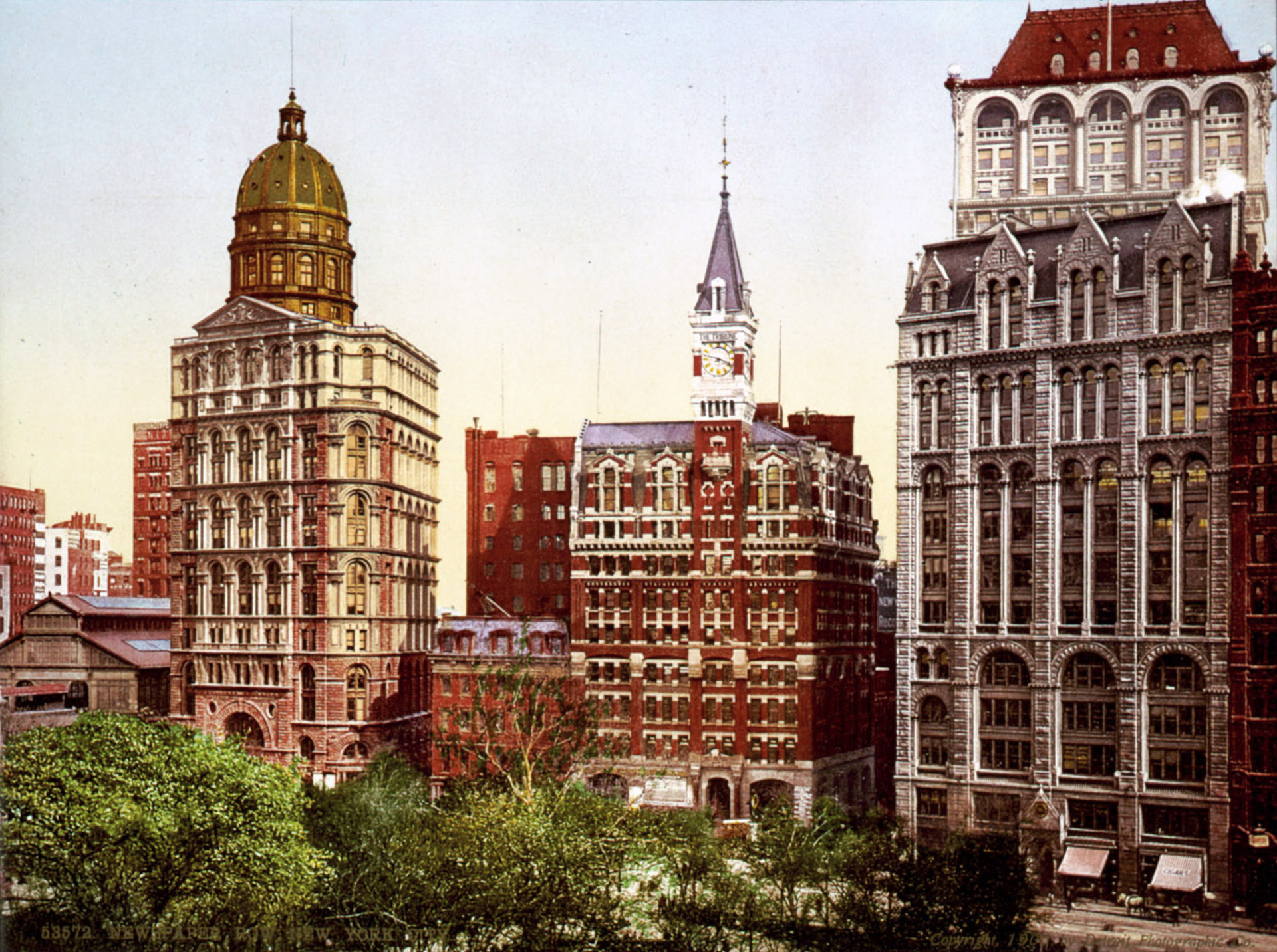 |
| Photo: The New York Times |
The New York Tribune Building was a building built by Richard Morris Hunt in 1875 in New York City. It was built as the headquarters of the New York Tribune and was a brick and masonry structure topped by a Clock Tower. It was 260 feet (79 m) tall and when new the second-tallest building in New York, after Trinity Church. It was demolished in 1966. The Tribune Building was located at 154 Printing House Square at Nassau and Spruce streets, on the site of an earlier Tribune building. It was one of the first high-rise elevator buildings. Originally a nine-story building, between 1903 and 1905 nine more floors were added by the architects D'Oench & Yost and L. Thouyard to make it an 18-story high. The building has been put forward as a candidate for the first ever skyscraper. Pace University held its first classrooms in the building, renting out one room in 1906. The building was demolished in 1966 to make room for the 1 Pace Plaza building.
The Tribune Building, on the site of two previous Tribune buildings, was announced in 1873 and completed in 1875 to designs by Richard Morris Hunt. It was a ten-story building when it opened, making it the second-tallest building in New York. Hunt's original design was not completed until 1882, when the building was extended to cover a larger lot area. Between 1905 and 1907, the mansard roof was removed and ten more floors were added by the architects D'Oench & Yost and L. Thouyard. The Tribune Building served as the Tribune's headquarters until 1922, but also housed office tenants, as well as the early classrooms of Pace University. It was demolished in 1966 to make room for Pace's 1 Pace Plaza building, and few remnants of the Tribune Building exist.
2. Equitable Life Building
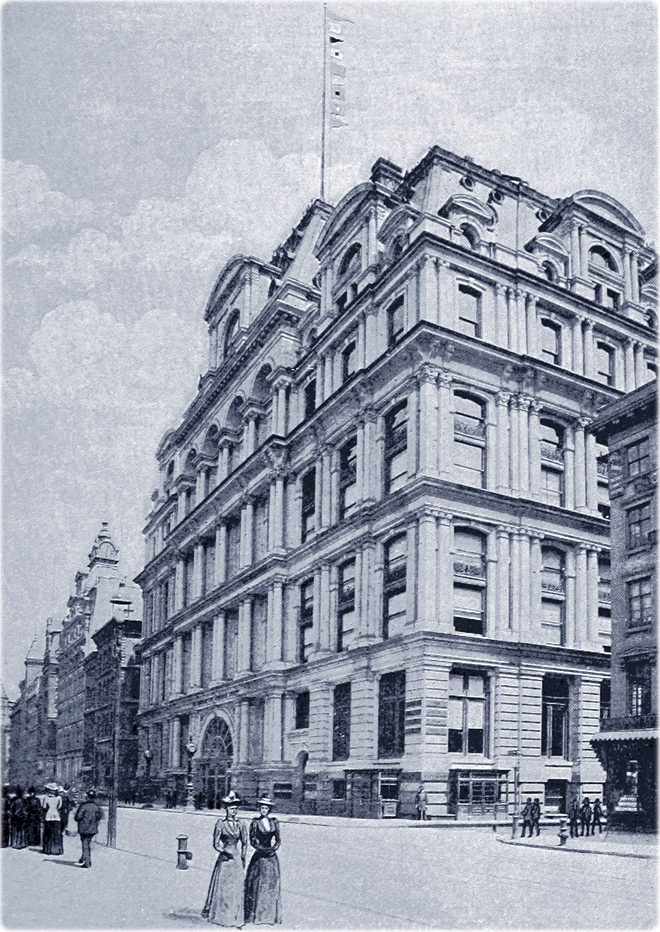 |
| Photo: Geographic guide |
The Old Equitable Building was an early skyscraper in New York, built between 1868 and 1870. Located at 120 Broadway, between Cedar Street and Pine Street, in the Financial District of Manhattan.
The architects were Edward Kendall and Arthur Gilman. It was built with seven above-ground stories and two basement levels, a huge granite edifice, covering entire block, at a height of 130 feet. It was one of the first buildings in Manhattan with passenger elevators.
The Equitable Life Assurance Society was organized in 1859. It was then a small company, but it grew immensely after the Civil War to become the largest life insurance company in the world, in 1886. In 1910, the building housed offices of Equitable Life Assurance Society, Mercantile Trust Co., Koumtze Bros., Mercantile Safe Deposit Co. and the Café Saverin.
The old Equitable Building was destroyed by fire on January 9, 1912. The company decided to erect a new building on the same site, the 40-story Equitable Building, completed in 1915, now a landmark.
1. Delaware Building
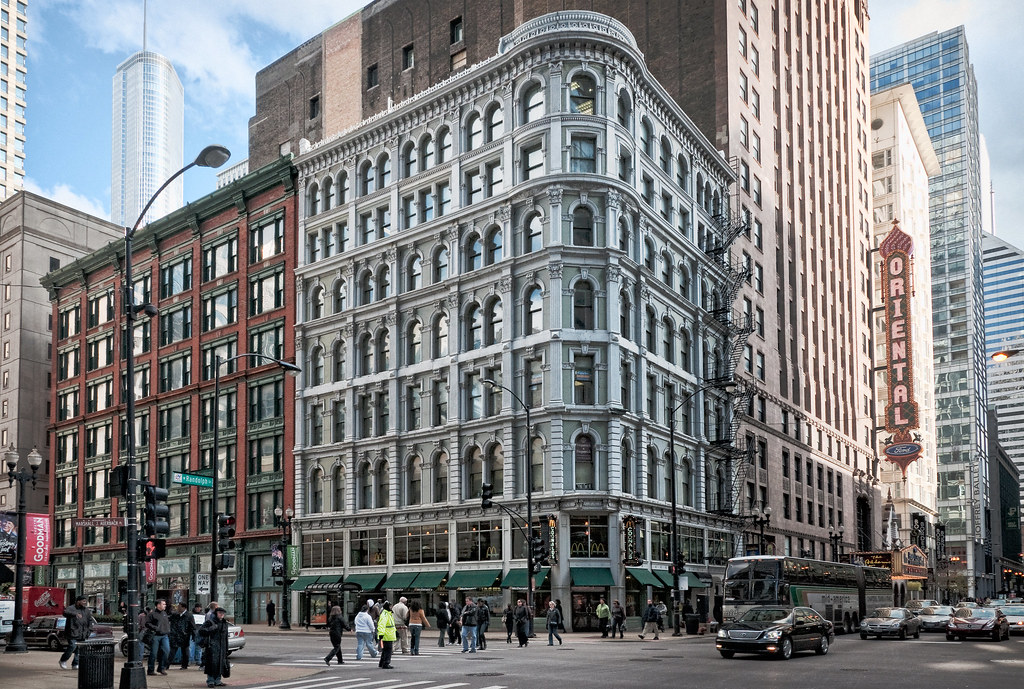 |
| Photo: Flickr |
The Delaware Building is a building in the Chicago Loop built in the massive rebuilding effort after the 1871 Great Chicago Fire. It is significant for being one of the few buildings to maintain its 1870s character, as an Italianate structure, in an area dominated by more modern structures. The building is also notable for its early use of a precast concrete façade. The building was designated a Chicago Landmark on November 23, 1983 and listed on the National Register of Historic Places on July 18, 1974.
As built, the building had five floors with a basement. The first two stories were primarily metal and glass to provide storefront windows for displays. In 1889, two additional floors were added, and three bays were removed from the Randolph Avenue façade.
 Top 10 Weirdest Creatures That Have Washed Ashore Top 10 Weirdest Creatures That Have Washed Ashore The ocean is as mysterious as it is deep. And in the bottom reaches of its waters lurk some strange, sometimes frightening, and ultimately fascinating ... |
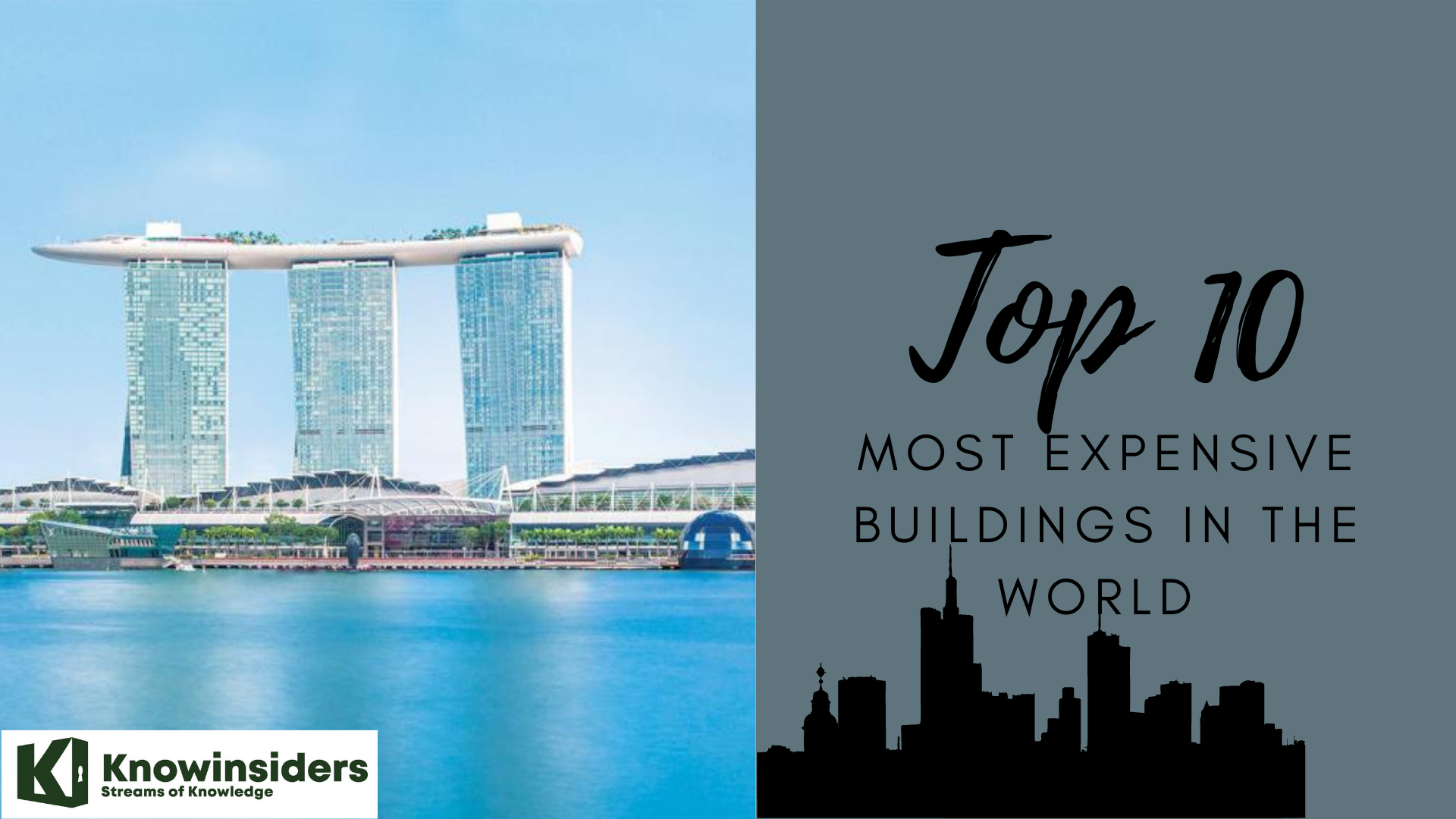 Top 10 Most Expensive Buildings In The World Top 10 Most Expensive Buildings In The World Buildings are not just for use, they can be extremely costly to build alone. Here are top 10 most expensive buildings in the world. |
 10 Famous Abandoned Buildings In The World 10 Famous Abandoned Buildings In The World Abandoned places have their own stories, and a glorious, important part, before left to rotten. Here is top 10 most famous abandoned buildings in the ... |
 Top 10 Oldest Buildings In The World - The First Buildings Top 10 Oldest Buildings In The World - The First Buildings Keep reading the detailed article below for the list of top 10 oldest buildings in the world - The First Buildings. |


























